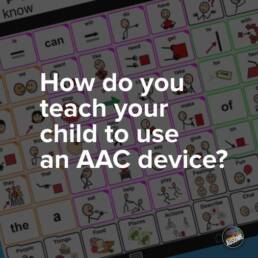So it has been recommended to us many times in the past to use an Augmented and Alternative Communication (AAC) device with Jonah.
I was hesitant to use one with him back then because I wanted to see how far he would go with his speech without the assistance.
Generally speaking, I didn’t want Jonah to become dependent on an assistive communication device if he didn’t absolutely need one.
It’s actually been years since it was first suggested, and Jonah has come a long ways with his speech.
But, because Jonah is the type of kid who will run before he learns to walk, he has also skipped some steps with his verbal abilities.
He never established a firm grasp of basic requests like “I want, I need, Can I, I am…” and so forth.
He also won’t respond to yes/no questions with an affirmative or negative answer.
For instance, “Yes” doesn’t mean an “affirmative” to him. It’s a construct that is only used during “teaching time.”
So if I ask him if he’s hungry, instead of replying with a “yes” or “no,” he will reply with a “hungry,” or “all done hungry,” to indicate his desire or lack of desire for food.
I can understand him just fine, but not everyone will. And I want to give Jonah all the tools I can for him to be successful on life.
So I thought about revisiting a “yes/no” app to help reinforce their individual meaning and the proper time to use them.
But there was so much more these “yes/no” apps could do.
Then I remembered the AAC app that so many people have raved about and bit the bullet and went ahead and purchased it.
But I have no idea how to introduce Jonah to it.
So Jonah has become super anxious when at home thanks to the pandemic. Home is no longer a “safe space” for him and anything even remotely resembling work has become an instant aversive.
So if I’m on my computer, Jonah’s screaming at me (if could turn into a zoom meeting with his teacher or class).
Same thing if I’m on the phone. Same thing when Jonny comes down the stairs in the morning.
Jonah screams at him to “STOP!” (When Jonny comes downstairs in the morning, it means he is getting ready for “school”… and we ‘can’t have that…’ “
Then he won’t let Jonny sit on the couch or chairs… because “anxiety…”
…and that really just a fraction of it… and that’s just at home… without him having to actually DO anything like schoolwork.
Literally, the last week of school last month, I told his teacher we would not be doing any work or participating in meetings.
It was all just too high a toll on Jonah’s mental health.
Home was no longer a safe place. Dad was no-longer a safe person (he could become ‘teacher dad’ at any time). And with no real “escape” from the possibility of work, Jonah’s “behaviors” spiked all around.
So I want to introduce him to this AAC app without it feeling like “school” or “work” to him.
I don’t want his tablet becoming an aversive because it is one thing he will consistently play with when he is actually inside.
Because this app…. huuuuu boy…
…WAS NOT CHEAP.
And the last thing I want is for Jonah to see it as “school work,” and not only not use it, but also become another deterrent in his learning.
How do you introduce an AAC app for the first time to a kid who doesn’t see it as a necessary device, who doesn’t want me handling his tablet or opening his apps, and who now HATES doing anything remotely resembling “work.” (If he even hears any piece of the word “work,” even in a YouTube video, he immediately responds with “all done work.”
What did you do (for those that use them)?
